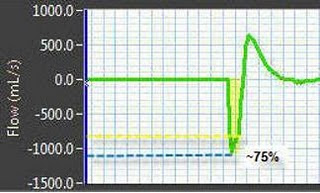 |
| Setting a T-Low based on a 50-75% PEFR may contribute to excessive exhaled tidal volumes |
There are three published techniques to set T-Low when utilizing Airway Pressure Release Ventilation (APRV) or mimicking (BiVent, BiLevel) the application.
They include:
1. Target a measured peak expiratory flow rate (PEFR) between 50-75% by T-Low setting [1].
a. Evaluating the expiratory flow waveform.
b. Setting the T-Low to one time constant.
2. Titrate T-Low to target tidal volume 4-6 cc/kg [2].
3. Set T-Low to 4 time constants to allow for complete exhalation & then titrate the P-Low to achieve a tidal volume of 4-6 cc/kg [3].
Until recently none of these techniques have been evaluated in regards to lung protective goals, mainly the prevention of excessive delivered tidal volumes.
Inconsistent tidal volume delivery is one reason why traditional lung protection techniques (ARDS NET) should be used in favor of APRV.
Mohammad Siddiquil & associates [4] compared these techniques using a mathematical model of pressure control ventilation and evaluated the predicted generated exhaled tidal volume and auto-PEEP.
The researchers concluded that methods 1 & 2 provided limited T-Low setting choices for ARDS patients with variable pulmonary mechanics. Additionally, these two methods generated potentially injurious exhaled tidal volumes and large amounts of auto-PEEP. Method three proved to provide the largest allowance of T-Low settings for the different ranges of lung compliance, resulted in the most stable tidal volume generation and the least amount of auto-PEEP.
[1]. Critical Care Medicine 2005; 33 [suppl.]:S228
[2]. http://ccmtutorials.com
[3]. Fundamentals of Mechanical Ventilation, 2nd Ed. 2006.
[4]. Siddiquil, M. et. al. (2010). Comparison of Three Methods to Set T-Low on Airway Pressure Release Ventilation: A Model Study. Respiratory Care. 2010 Open Forum Abstract.